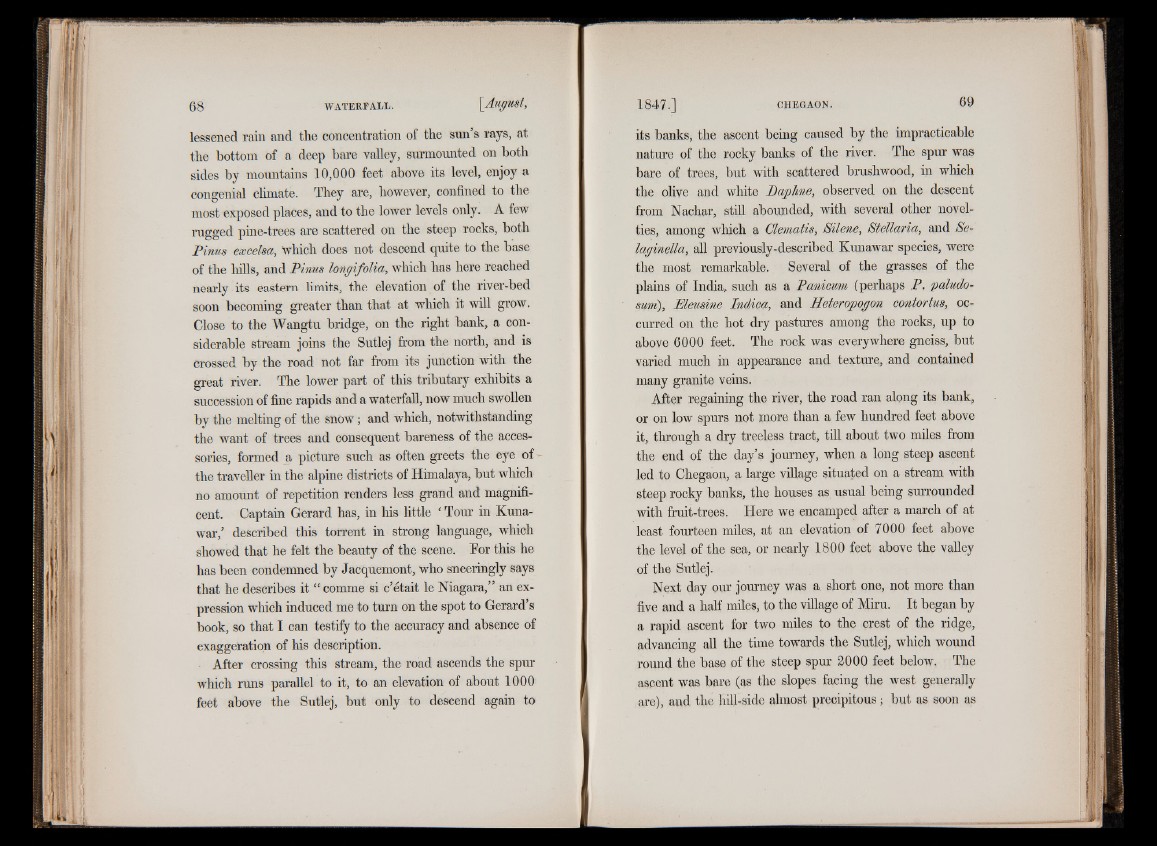
lessened rain and the concentration of the sun’s rays, at
the bottom of a deep bare valley, surmounted on both
sides by mountains 10,000 feet above its level, enjoy a
congenial climate. They are, however, confined to the
most exposed places, and to the lower levels only. A few
rugged pine-trees are scattered on the steep rocks, both
Pinus excelsa, which does not descend quite to the base
of the hills, and Pinus longifolia, which has here reached
nearly its eastern limits, the elevation of the river-bed
soon becoming greater than that at which it will grow.
Close to the Wangtu bridge, on the right bank, a considerable
stream joins the Sutlej from the north, and is
crossed by the road not far from its junction with the
great river. The lower part of this tributary exhibits a
succession of fine rapids and a waterfall, now much swollen
by the melting of the snow; and which, notwithstanding
the want of trees and consequent bareness of the accessories,
formed a picture such as often greets the eye of
the traveller in the alpine districts of Himalaya, but which
no amount of repetition renders less grand and magnificent.
Captain Gerard has, in his little ‘ Tour in Kuna-
war,’ described this torrent in strong language, which
showed that he felt the beauty of the scene. Tor this he
has been condemned by Jacquemont, who sneeringly says
that he describes it “ comme si c’etait le Niagara,” an expression
which induced me to turn on the spot to Gerard’s
book, so that I can testify to the accuracy and absence of
exaggeration of his description.
After crossing this stream, the road ascends the spur
which runs parallel to it, to an elevation of about 1000
feet above the Sutlej, but only to descend again to
its banks, the ascent being caused by the impracticable
nature of the rocky banks of the river. The spur was
bare of trees, but with scattered brushwood, in which
the olive and white Daphne, observed on the descent
from Nachar, still abounded, with several other novelties,
among which a Clematis, Silene, Stettaria, and Se-
laginella, all previously-described Kunawar species, were
the most remarkable. Several of the grasses of the
plains of India, such as a Panicmn (perhaps P. paludo-
surn), Eleusine Indica, and Heteropogon contortus, occurred
on the hot dry pastures among the rocks, up to
above 6000 feet. The rock was everywhere gneiss, but
varied much in appearance and texture, and contained
many granite veins.
After regaining the river, the road ran along its bank,
or on low spurs not more than a few hundred feet above
it, through a dry treeless tract, till about two miles from
the end of the day’s journey, when a long steep ascent
led to Chegaon, a large village situated on a stream with
steep rocky banks, the houses as usual being surrounded
with fruit-trees. Here we encamped after a march of at
least fourteen miles, at an elevation of 7000 feet above
the level of the sea, or nearly 1800 feet above the valley
of the Sutlej.
Next day our journey was a. short one, not more than
five and a half miles, to the village of Miru. It began by
a rapid ascent for two miles to the crest of the ridge,
advancing all the time towards the Sutlej, which wound
round the base of the steep spur 2000 feet below. The
ascent was bare (as the slopes facing the west generally
are), and the liill-side almost precipitous; but as soon as